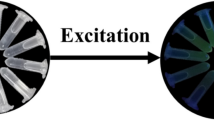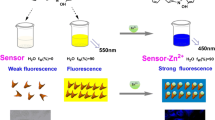Abstract
A sensitive and biocompatible N-rich probe for rapid visual uranium detection was constructed by grafting two trianiline groups to 2,6-bis(aminomethyl)pyridine. Possessing excellent aggregation-induced emission (AIE) property and the advantages to form multidentate chelate with U selectively, the probe has been applied successfully to visualize uranium in complex environmental water samples and living cells, demonstrating outstanding anti-interference ability against large equivalent of different ions over a wide effective pH range. A large linear range (1.0 × 10−7–9.0 × 10−7 mol/L) and low detection limit (72.6 nmol/L, 17.28 ppb) were achieved for the visual determination of uranium. The recognition mechanism, photophysical properties, analytical performance and cytotoxicity were systematically investigated, demonstrating high potential for fast risk assessment of uranium pollution in field and in vivo.
Graphical Abstract








Similar content being viewed by others
Data availability
The data that supports the research findings can be found in the main manuscript and the electronic supplementary materials.
References
Park DM, Taffet MJ (2019) Combinatorial sensor design in caulobacter crescentus for selective environmental uranium detection. ACS Synth Biol 8:807–817. https://doi.org/10.1021/acssynbio.8b00484
Parsons J, Buongiorno J, Corradini M, Petti D (2019) A fresh look at nuclear energy. Science 363:105–105. https://doi.org/10.1126/science.aaw5304
Wen Y, Yuan Y, Li L, Ma D, Liao Q, Hou S (2017) Ultrasensitive DNAzyme based amperometric determination of uranyl ion using mesoporous silica nanoparticles loaded with Methylene Blue. Microchim Acta 184:3909–3917. https://doi.org/10.1007/s00604-017-2397-7
Jiao X, Dong Z, Baccolo G, Qin X, Wei T, Di J, Shao Y (2024) Quantifying uranium radio-isotope ratios in riverine suspended particulate matter: insights into natural and anthropogenic influences in the glacialfed river system of the NE Tibetan Plateau. J Hazard Mater 461:132725. https://doi.org/10.1016/j.jhazmat.2023.132725
Reeves B, Beccia MR, Solari PL, Smiles DE, Shuh DK, Berthomieu C, Marcellin D, Bremond N, Mangialajo L, Pagnotta S, Monfort M, Moulin C, Den Auwer C (2019) Uranium uptake in paracentrotus lividus sea urchin, accumulation and speciation. Environ Sci Technol 53:7974–7983. https://doi.org/10.1021/acs.est.8b06380
Gao N, Huang Z, Liu H, Hou J, Liu X (2019) Advances on the toxicity of uranium to different organisms. Chemosphere 237:124548. https://doi.org/10.1016/j.chemosphere.2019.124548
Chen M, Lang L, Chen L, Wang X, Shi C, Sun Q, Xu Y, Diwu J, Wang S (2022) Improving in vivo uranyl removal efficacy of a nano-metal organic framework by interior functionalization with 3-hydroxy-2-pyridinone. Chin J Chem 40:2054–2060. https://doi.org/10.1002/cjoc.202200206
Guidelines for drinking-water quality: fourth edition incorporating the first addendum. Geneva: World Health Organization; 2017. Licence: CC BY-NC-SA 3.0 IGO.
Arbova DL, Tolmachev SY, Brockman JD (2024) A multi-collector ICP-MS method for quantification of plutonium, uranium, and americium in hair and nails of occupationally or medically exposed individuals. Talanta 270:125607. https://doi.org/10.1016/j.talanta.2023.125607
Déjeant A, Bourva L, Sia R, Galoisy L, Calas G, Phrommavanh V, Descostes M (2014) Field analyses of 238U and 226Ra in two uranium mill tailings piles from Niger using portable HPGe detector. J Environ Radioact 137:105–112. https://doi.org/10.1016/j.jenvrad.2014.06.012
Wang S, Yang S, Wu H, Jiang J, Shao L, Ren Y, Li Y, Liang C, Chu M, Wang X (2019) The contribution of photoinduced charge-transfer enhancement to the SERS of uranyl (VI) in a uranyl-Ag2O complex. Sci Bull 64:315–320. https://doi.org/10.1016/j.scib.2019.01.025
Wang Q, Zhang H, Yu D, Qin W, Wu X (2022) Ultra-sensitive and stable N-doped carbon dots for selective detection of uranium through electron transfer induced UO22+(V) sensing mechanism. Carbon 198:162–170. https://doi.org/10.1016/j.carbon.2022.07.036
Cui W-R, Zhang C-R, Jiang W, Li F-F, Liang R-P, Liu J, Qiu J-D (2020) Regenerable and stable sp2 carbon-conjugated covalent organic frameworks for selective detection and extraction of uranium. Nat Commun 11:436. https://doi.org/10.1038/s41467-020-14289-x
Liu W, Dai X, Bai Z, Wang Y, Yang Z, Zhang L, Xu L, Chen L, Li Y, Gui D, Diw-u J, Wang J, Zhou R, Chai Z, Wang S (2017) Highly sensitive and selective uranium detection in natural water systems using a luminescent mesoporous metal-organic framework equipped with abundant lewis basic sites: a combined batch, X-ray absorption spectroscopy, and first principles simulation investigation. Environ Sci Technol 51:3911. https://doi.org/10.1021/acs.est.6b06305
Ma J, He W, Han X, Hua D (2017) Amidoximated fluorescent polymer based sensor for detection of trace uranyl ion in aqueous solution. Talanta 168:10–15. https://doi.org/10.1016/j.talanta.2017.02.058
Huang Y, Xing J, Gong Q, Chen L-C, Liu G, Yao C, Wang Z, Zhang H-L, Chen Z, Zhang Q (2019) Reducing aggregation caused quenching effect through co-assembly of PAH chromophores and molecular barriers. Nat Commun 10:169. https://doi.org/10.1038/s41467-018-08092-y
Luo JD, Xie ZL, Lam JWY, Cheng L, Chen HY, Qiu CF, Kwok HS, Zhan XW, Liu YQ, Zhu DB, Tang BZ (2001) Aggregation-induced emission of 1-methyl-1,2,3,4,5-pen-taphenylsilole. Chem. Commun: 1740–1741. https://doi.org/10.1039/b105159h
Xu Y, Liang N, Liu J, Gong X, Yan P, Sun S (2022) Design and fabrication of chitosan-based AIE active micelles for bioimaging and intelligent del-ivery of paclitaxel. Carbohydr Polym 290:119509. https://doi.org/10.1016/j.carbpol.2022.119509
Lin N, Ren W, Hu J, Gao B, Yuan D, Wang X, Fu J (2019) A novel tetraphenylethene-based fluorescent sensor for uranyl ion detection with aggregation-induced emission character. Dyes Pigm 166:182–188. https://doi.org/10.1016/j.dyepig.2019.02.048
Wen J, Huang Z, Hu S, Li S, Li W, Wang X (2016) Aggregation-induced emission active tetraphenylethene-based sensor for uranyl ion detection. J Hazard Mater 318:363–370. https://doi.org/10.1016/j.jhazmat.2016.07.004
Ding H, Li C, Zhang H, Lin N, Ren W-S, Li S, Liu W, Xiong Z, Xia B, Wang C-C (2023) A simple fluorescent sensor for highly sensitive detection of UO22+. Chin Chem Lett 34:107725. https://doi.org/10.1016/j.cclet.2022.08.005
Zheng M, Yin Q, Wang D, Zhao Z, Hu Q, Wang H (2021) A fluorescent probe of uranyl for acid and high water system and imaging in living cells. Microchem J 167:106302. https://doi.org/10.1016/j.microc.2021.106302
Ning G, Mu P, Li B, Liu J, Xiao Q, Huang S (2022) Fluorine and nitrogen co-doped near-infrared carbon dots for fluorescence “on–off-on” determination of nitrite. Microchim Acta 189:230. https://doi.org/10.1007/s00604-022-05337-y
Chen B, Hong S, Dai X, Li X, Huang Q, Sun T, Cao D, Zhang H, Chai Z, Diwu J, Wang S (2022) In vivo uranium decorporation by a tailor-made hexadentate ligand. J Am Chem Soc 144:11054–11058. https://doi.org/10.1021/jacs.2c00688
Li Y, Zheng Y, Ahamd Z, Zhu L, Yang J, Chen J, Zhang Z (2023) Strategies for designing highly efficient adsorbents to capture uranium from seawater. Coord Chem Rev 491:215234. https://doi.org/10.1016/j.ccr.2023.215234
Hardy EE, Wyss KM, Eddy MA, Gorden AEV (2017) An example of unusual pyridine donor Schiff base uranyl (UO22+) complexes. Chem Commun 53:5718–5720. https://doi.org/10.1039/C7CC02747H
Wu XY, Cui AQ, Ye JB, Song G, Wu YN, Wu YX, Lai JP, Sun H (2023) Novel biocompatible and sensitive visual sensor based on aggregation-induced emission for on-site detection of radioactive uranium in water and live cell imaging. Sci Total Environ 858:159796. https://doi.org/10.1016/j.scitotenv.2022.159796
Kwok RTK, Leung CWT, Lam JWY, Tang BZ (2015) Biosensing by luminogens with aggregation-induced emission characteristics. Chem Soc Rev 44:4228–4238. https://doi.org/10.1039/c4cs00325j
Liang J, Tang BZ, Liu B (2015) Specific light-up bioprobes based on AIEgen conjugates. Chem Soc Rev 44:2798–2811. https://doi.org/10.1039/C4CS00444B
Kenry TBZ, Liu B (2020) Catalyst: aggregation-induced emission—how far have we come, and where are we going next? Chem 6:1195–1198. https://doi.org/10.1016/j.chempr.2020.05.018
Yin H, Li B, Zhao X, Liu Y, Shi Y, Ding D (2022) Restriction of intramolecular torsion induces abnormal blue-shifted fluorescence in the aggregate state. Dyes Pigm 201:110192. https://doi.org/10.1016/j.dyepig.2022.110192
Liu B, Cui W, Zhou J, Wang H (2022) A novel triphenylamine-based flavonoid fluorescent probe with high selectivity for uranyl in acid and high water systems. Sensors 22:186987. https://doi.org/10.3390/s22186987
Wu X, Mao Y, Wang D, Huang Q, Yin Q, Zheng M, Hu Q, Wang H (2020) Designing a colorimetric sensor containing nitrogen and oxygen atoms for uranyl ions identification: chromatic mechanism, binding feature and on-site application. Sens Actuators B Chem 307:127681. https://doi.org/10.1016/j.snb.2020.127681
Wang L, Yang X, Chen X, Zhou Y, Lu X, Yan C, Xu Y, Liu R, Qu J (2017) A novel fluorescence probe based on triphenylamine Schiff base for bioimaging and responding to pH and Fe3+. Mater Sci Eng C 72:551–557. https://doi.org/10.1016/j.msec.2016.11.108
Qin X, Yang W, Yang Y, Gu D, Guo D, Pan Q (2020) A zinc metal-organic framework for concurrent adsorption and detection of uranium. Inorg Chem 59:9857–9865. https://doi.org/10.1021/acs.inorgchem.0c01072
Zhang C-R, Cui W-R, Jiang W, Li F-F, Wu Y-D, Liang R-P, Qiu J-D (2020) Simultaneous sensitive detection and rapid adsorption of UO22+ based on a post-modified sp2 carbon-conjugated covalent organic framework. Environ Sci Nano 7:842–850. https://doi.org/10.1039/C9EN01225G
Cui WR, Xu W, Qiu WB (2023) Constructing an ultrastable imidazole covalent organic framework for concurrent uranium detection and recovery. Ecotoxicol Environ Saf 252:114639. https://doi.org/10.1016/j.ecoenv.2023.114639
Huang C, Fan X, Yuan Q, Zhang X, Hou X, Wu P (2018) Colorimetric determination of uranyl (UO22+) in seawater via DNAzyme-modulated photosensitization. Talanta 185:258–263. https://doi.org/10.1016/j.talanta.2018.03.079
Zhang Z, Zhang D, Shi C, Liu W, Chen L, Miao Y, Diwu J, Li J, Wang S (2019) 3,4-Hydroxypyridinone-modified carbon quantum dot as a highly sensitive and selective fluorescent probe for the rapid detection of uranyl ions. Environ Sci Nano 6:1457–1465. https://doi.org/10.1039/C9EN00148D
Lee S, Kim KY, Lim NY, Jung JH, Lee JH, Choi MY, Jung JH (2019) Terpyridine-based complex nanofibers with Eu3+ as a highly selective chemical probes for UO22+. J Hazard Mater 378:120713. https://doi.org/10.1016/j.jhazmat.2019.05.106
Kumar RS, Venkatesan V, Bhaskar R, Kumar SKA, Sivaramakrishna A, Vijayakrishna K, Brahmmananda Rao CVS, Sivaraman N, Sahoo SK (2021) Rapid detection strategies for the ultra-level chemosensing of uranyl ions. Dalton Trans 50:14706–14713. https://doi.org/10.1039/D1DT01803E
Funding
This work was supported by the National Natural Science Foundation of China (22376041, 22276043, 21876033, and 42230719); Guangzhou Science and Technology Plan Project (2023A03J0035); Earth Critical Zone and Eco-geochemistry (PT252022024); and College Student Innovation and Entrepreneurship Project (S202311078054).
Author information
Authors and Affiliations
Corresponding authors
Ethics declarations
Competing interests
The authors declare no competing interests.
Additional information
Publisher's Note
Springer Nature remains neutral with regard to jurisdictional claims in published maps and institutional affiliations.
Supplementary Information
Below is the link to the electronic supplementary material.
Rights and permissions
Springer Nature or its licensor (e.g. a society or other partner) holds exclusive rights to this article under a publishing agreement with the author(s) or other rightsholder(s); author self-archiving of the accepted manuscript version of this article is solely governed by the terms of such publishing agreement and applicable law.
About this article
Cite this article
Xu, J., Wang, S., Yi, Z. et al. Novel biocompatible N-rich AIE fluorescent probe for live cell imaging and visual onsite detection of uranium. Microchim Acta 191, 302 (2024). https://doi.org/10.1007/s00604-024-06390-5
Received:
Accepted:
Published:
DOI: https://doi.org/10.1007/s00604-024-06390-5




